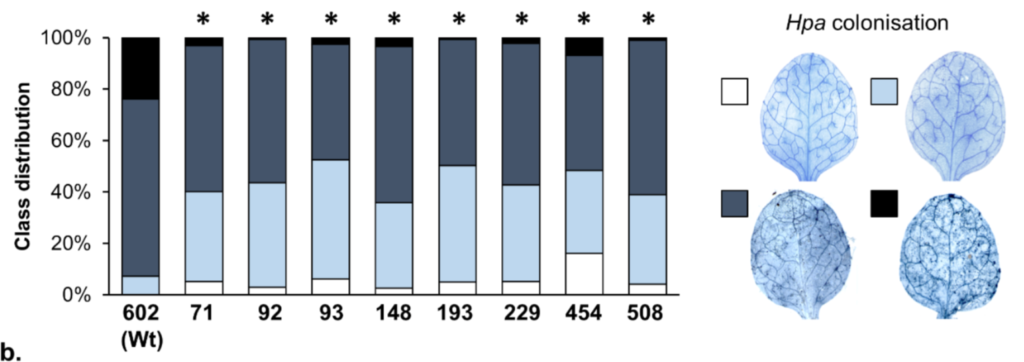The inaugural GARNet Research Roundup of 2019 firstly includes a paper from the University of Sheffield that has identified new pericentromeric epigenetic loci that affect the pathogen response. Secondly is a collaboration between researchers in Birmingham, Nottingham and Oxford that has identified a new mode of regulation of the VRN2 protein. Next are two papers from Jonathan Jones’ lab at The Sainsbury Laboratory in Norwich that firstly provides a toolkit for gene editing in Arabidopsis and secondly characterise the role of the NRG1 gene in the defense response. The penultimate paper is from Paul Devlin’s lab at RHUL and investigates the role of the circadian clock in the control of leaf overtopping whilst the final paper is a meeting report from a recent GARNet workshop on gene editing.
Furci L, Jain R, Stassen J, Berkowitz O, Whelan J, Roquis D, Baillet V, Colot V, Johannes F, Ton J (2019) Identification and characterisation of hypomethylated DNA loci controlling quantitative resistance in Arabidopsis. Elife. doi: 10.7554/eLife.40655.
Open Access
Leonardo Furci and Ritushree Jain are the lead authors on this study conducted at the University of Sheffield. The authors used a population of epigenetic recombinant inbred lines (epiRILs) to screen for resistance to the oomycete pathogen Hyaloperonospora arabidopsidis. These lines each share genetic information but have varied epigenetic changes. This analysis enabled the identification of plants with hypomethylated pericentromeric regions that were primed to better respond to the presence of this pathogen. The authors discuss the mechanism through which this might affect the defence response albeit without altering other aspects of plant growth.

Gibbs
DJ, Tedds HM, Labandera AM, Bailey M, White MD, Hartman S, Sprigg C,
Mogg SL, Osborne R, Dambire C, Boeckx T, Paling Z, Voesenek LACJ,
Flashman E, Holdsworth MJ (2018) Oxygen-dependent proteolysis regulates the stability of angiosperm polycomb repressive complex 2 subunit VERNALIZATION 2. Nat Commun. doi: 10.1038/s41467-018-07875-7
Open Access
This collaboration between the Universities of Birmingham, Nottingham, Oxford and colleagues in Utrecht is led by Daniel Gibbs. They demonstrate that the amount of VRN2 protein, which is a member of the Polycomb Repressive Complex2, is controlled by the N-end rule pathway and that this regulation responses to both cold and hypoxia stress. Whilst the VRN2 gene is expressed throughout the plant, the N-end rule degradation pathway ensures that the protein is restricted to meristematic regions until the plant senses the appropriate abiotic stress. Classically VRN2 has been linked to the regulation of flowering time by altering gene expression at the FLC locus so this study introduces new complexity into this process through the involvement of the N-end rule pathway. More information on this linkage will undoubtedly follow over the coming years.
Daniel kindly discusses this paper on the GARNet YouTube channel.
Castel B, Tomlinson L, Locci F, Yang Y, Jones JDG (2019) Optimization of T-DNA architecture for Cas9-mediated mutagenesis in Arabidopsis. PLoS One. doi: 10.1371/journal.pone.0204778
Open Access
Baptiste Castel is lead author of this work conducted at the Sainsbury Laboratory, Norwich in Jonathan Jones’ group. They have conducted a detailed analysis of the factors that contribute to successful gene editing by CRISPR-Cas9, specifically in Arabidopsis. This includes assessing the efficacy of different promotor sequences, guideRNAs, versions of Cas9 enzyme and associated regulatory sequences in the editing of a specific locus. Given that researchers are finding that different plants have different requirements when it comes to successful gene editing, this type of analysis will be invaluable for anyone who plans to conduct a gene editing experiment in Arabidopsis.

Castel B, Ngou PM, Cevik V, Redkar A, Kim DS, Yang Y, Ding P, Jones JDG (2018) Diverse NLR immune receptors activate defence via the RPW8-NLR NRG1. New Phytol. doi: 10.1111/nph.15659
In this second paper led by Baptiste Castel, they used the techniques outlined in the paper above to generate a set of CRISPR mutants deficient in NRG1, which is a RPW8-NLR resistance (R) gene. These nrg1 mutants have compromised signalling in all tested downstream TIR-NLR resistance genes. In addition the authors demonstrate that this signalling is needed for resistance to oomycete but not bacterial infection. Therefore this study reveals some significant details regarding the components of the disease response that are influenced by the activity of NRG1.
Woodley Of Menie MA, Pawlik P, Webb MT, Bruce KD, Devlin PF (2018) Circadian leaf movements facilitate overtopping of neighbors. Prog Biophys Mol Biol. doi: 10.1016/j.pbiomolbio.2018.12.012
This work is led by Michael Woodley Of Menie from Paul Devlin’s lab at Royal Holloway College and investigates the role of circadian leaf movements during shade avoidance and overtopping. Arabidopsis plants were grow in a grid system that meant leaves would interact with their neighbours and the authors show that plants with a normal circadian rhythm gained an advantage over those adapted to a longer period in which they were grown. This overtopping was additive to the advantage gained through shade avoidance and overall this paper shows that maintainance of clock-aligned leaf movements are beneficial to growth.
Parry G, Harrison CJ (2019) GARNet gene editing workshop. New Phytol. doi: 10.1111/nph.15573
Open Access
GARNet advisory committee member Jill Harrison and GARNet coordinator Geraint Parry are authors on this meeting report resulting from a GARNet organised workshop on gene editing that took place in March 2018 at the University of Bristol. Coincidentally part of the paper discusses the work that was presented at the meeting by Baptiste Castel, which is published in the paper described above.

